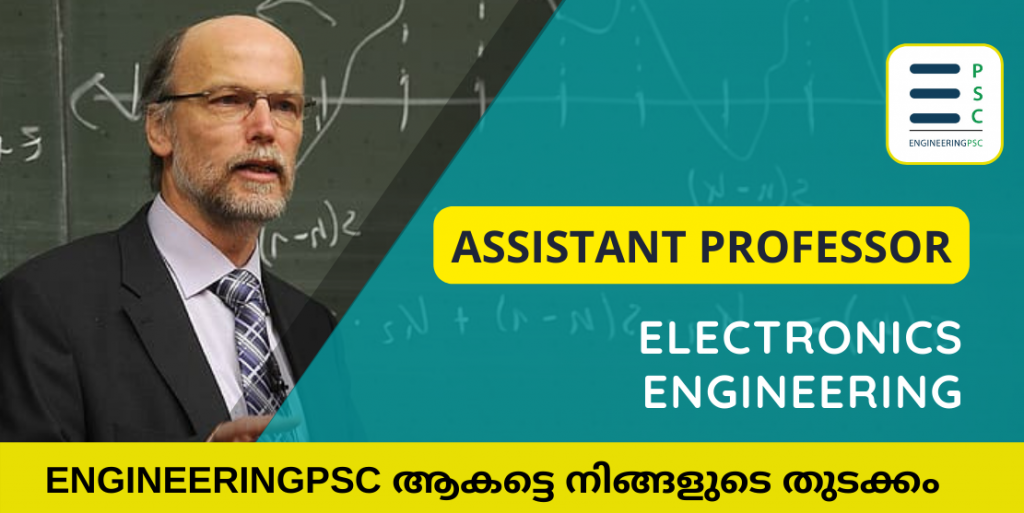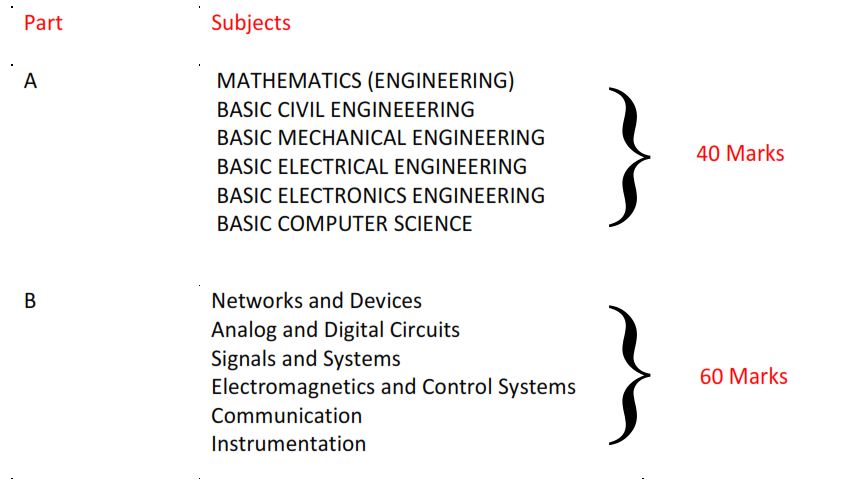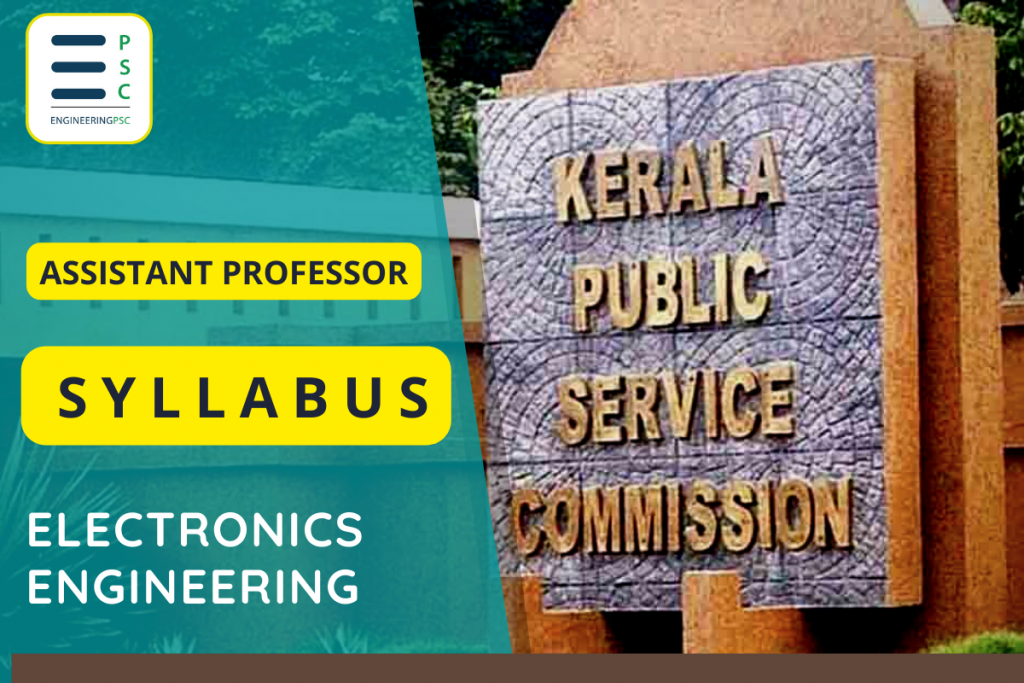
Assistant professor in government engineering college exam published in 2022. The syllabus comprises of two parts as given below

- Mode of Exam: MCQ (OMR)
- Exam contains 100 Questions
- Each correct answer carry one mark & 0.33 detected for wrong answers
- Total time allotted : 1hr 15 min
Do you believe that all questions comes from the syllabus ?
NO, Thorough knowledge of subject is required since question from outside can be expected. In the recent years we can see a trend of deviation in questions in the technical exams conducted by the Kerala PSC.
Will only studying topics in syllabus fetch me a GOVT Job?
Do not blindly follow the syllabus rather have good technical knowledge of your subjects. If you check the previous year papers you could find out many questions coming outside the syllabus in all technical exams by Kerala PSC.

ELECTRONICS AND COMMUNICATION / APPLIED ELECTRONICS & INSTRUMENTATION
SYLLABUS
MATHEMATICS (ENGINEERING)
Matrices: Rank, systems of linear equations, consistency, eigen values, eigen vectors, Cayley Hamilton Theorem, diagonalisation, linear dependence and independence of vectors.
Demo Class : Click Here
Partial Differentiation: Partial derivatives, Euler’s theorem on homogeneous functions, total derivatives, Jacobians, Taylor’s series (one and two variables) – Maxima and minima of functions of two variables – Lagrange’ s method.
Vector Differentiation: Scalar and vector functions, differentiation of vector functions – velocity and acceleration – scalar and vector fields – operator Ñ – Gradient – Directional derivative – Divergence – Curl – irrotational and solenoidal fields – scalar potential.
Laplace Transforms: Transforms of elementary functions, shifting property – inverse transforms – transforms of derivatives and integrals – transform of functions multiplied by t and divided by t – convolution theorem, solution of ordinary differential equations with constant coefficients using Laplace transforms.
Ordinary Differential Equations: First Order ordinary differential equations, systems of linear first order ordinary differential equations, linear ordinary differential equations of higher order with constant coefficients, linear second order ordinary differential equations with variable coefficients (Cauchy and Legendre equations), Method of Laplace transforms for solving ordinary differential equations.
Complex Analysis: Analytic functions, conformal mappings, bilinear transformations, complex integration, Cauchy’s integral theorem and formula, Taylor and Laurent’s series, residue theorem.
Fourier Series: Fourier series of periodic functions of period 2 π and 2 ℓ, odd and even functions, Half range expansions.
BASIC CIVIL ENGINEEERING
Mechanics – statistics – Coplanar forces – conditions of equilibrium. Support reactions – Simply supported and overhanging beams. Friction – Laws of friction – applications. Centre of gravity and moment of inertia of plane areas. Dynamics – rectilinear motion – Newton’s laws of motion – curvilinear motion.
Building materials – common building materials – stone, brick, cement, steel, aggregate, concrete, timber – properties, IS specification. Building construction – types and functions of the following structural components of buildings – foundations and superstructure.
Surveying – principle of surveying – linear measurements using chain – levelling work – reduction of levels.
Demo Class : Click Here
BASIC MECHANICAL ENGINEERING
Zeroth, first and second laws of thermodynamics, CI and SI Engines, properties of steam. Centrifugal and reciprocating pumps, hydraulic turbines, refrigeration and air conditioning, hydro-electric, thermal and nuclear power plants, mechanical power transmission systems such as belt, rope, chain and gear, manufacturing process – casting, forging, rolling, brazing, soldering, and welding, machining process – turning, shaping, drilling, grinding and milling. Conic sections and miscellaneous curves, orthographic, isometric and perspective projections.
Demo Class : Click Here
BASIC ELECTRICAL ENGINEERING
Ohm’s law, Kirchoff’s laws – solution of series and parallel circuits with dc excitation.
Magnetic circuits: MMF, field strength, flux density, reluctance, electromagnetic induction, Faraday’s laws, Lenz’s law, statically and dynamically induced emfs, self and mutual induction, co-efficient of coupling.
Principle of generation of alternating current – waveforms – frequency, period, average and rms values, form factor.
Generation of 3 phase ac voltage, star and delta connections, voltage & current relationships in star and delta (balanced system only). Principle of operation of dc motor & generator, single phase transformer and three phase induction motor.
Types of lamps, necessity of earthing.
BASIC ELECTRONICS ENGINEERING
Devices – working principle of PN junction, Zener diode and BJT.
Systems – Rectifiers : Half wave, Full wave and Bridge. Filters: Capacitors and
Inductors.
Amplifiers & Oscillators – Common Emitter RC coupled amplifier and its frequency response. Principles of Wein-bridge oscillator. Op-amps: Basics, inverting and non- inverting amplifier.
Communication – Need for modulation, principles of AM and FM. Measurements – Working principles of CRO and Multimeter.
BASIC COMPUTER SCIENCE
Functional units of a computer.
Programming in C – control structures, functions.
Networks and Devices
Network theorems: superposition, Thevenin and Norton’s maximum power transfer, time domain analysis of simple RC, RL and RLC circuits, solution of network equations using Laplace transform: frequency domain analysis of RL, RC and RLC circuits, 2-port network parameters: driving point and transfer functions.
Electronic Devices: Energy bands in silicon, carrier transport in silicon, diffusion current, drift current, mobility and resistivity, generation and recombination of carriers, working principles of p-n junction diode, Zener diode, tunnel diode, BJT, JFET, MOSFET, LED and photo diode.
Analog and Digital Circuit
Simple diode circuits: clipping & clamping, biasing and bias stability of BJTs and MOSFETs, small signal equivalent circuits of BJTs and MOSFETs. Amplifiers: single stage, differential, feedback and power. Frequency response of amplifiers. Op- amp circuits: Inverting, non-inverting, Integrator and Comparator. Sinusoidal Oscillators: criterion for oscillation, single transistor and op-amp configurations. Boolean algebra, minimization of Boolean functions, logic gates, combinational Circuits: arithmetic circuits, code converters, multiplexers and decoders, sequential circuits: latches and flip-flops, counters and shift registers, ADCs and DACs, microprocessor (8085): architecture and programming.
Demo Class : Click Here
Signals and Systems
Introduction to signals and systems, Linear Time-invariant (LTI systems): definitions and properties, causality, stability, impulse response and convolution, continuous-time and discrete-time Fourier series, continuous-time and discrete-time Fourier Transform Z-transform: definition, properties and inverse, stability analysis using pole-zero plot, difference equation solution using unilateral Z-transform, DFT and its properties, FFT: radix 2 and composite radix algorithm, sampling theorem, realization of IIR and FIR structures – parallel and cascade structure, frequency response, group delay and phase delay, signal transmission through LTI systems.
Electromagnetics and Control Systems
Elements of vector calculus: divergence and curl, Gauss and Stokes theorems, Maxwell’s equations, differential and integral forms, wave equation, Poynting vector, Plane waves: propagation through various media, reflection and refraction, phase and group velocity and skin depth, Transmission lines: characteristic impedance, impedance transformation. Waveguides: modes in rectangular waveguides, boundary conditions, cut-off frequencies and dispersion relations, basics of propagation in dielectric waveguide and optical fibres, basics of Antennas: Dipole antennas, radiation pattern, antenna gain.
Introduction to control systems, signal flow graphs and their use in determining transfer functions of systems, transient and steady state analysis of LTI control systems and frequency response, tools and techniques for LTI control system analysis: root loci, Routh-Hurwitz criterion, Bode and Nyquist plots.
Communication
Analog communication systems: amplitude and angle modulation and demodulation systems, superheterodyne receivers, signal-to-noise ratio (SNR). Digital communication systems: pulse code modulation (PCM), differential pulse code modulation (DPCM), digital modulation schemes: amplitude, phase and frequency shift keying schemes, matched filter receivers, fundamentals of information theory and channel capacity theorem, random signals and noise: probability, random variables, probability density function, autocorrelation, power spectral density.
Demo Class : Click Here
Instrumentation
Static and dynamic characteristics of Measurement systems: Measurement of displacement, velocity and acceleration, force, basics of fiber optics, biomedical instruments, EEG, ECG and EMG, Clinical measurements, ultrasonic transducers.
Reference : Click Here

